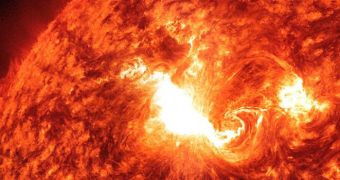The Sun indeed appears to be approaching the period of maximum activity in its 11-year cycle. As evidence to this fact, astronomers say that the star has just released a powerful, X5.4-class solar flare earlier today, starting at 00:28 UT.
The event originated in Active Region 1429, the same area of intense solar activity that caused another X-class solar storm on March 5. Solar physicists are surprised that such large flares (and subsequent coronal mass ejections) occurred so fast in relation to each other, and from the same source.
NASA detected the event by using its Solar Dynamics Observatory (SDO), more specifically the Atmospheric Imaging Assembly (AIA) instrument. The CME produced earlier today may hit the planet, but experts don't yet know how strong the impact will be.
According to experts, an X5-class storm is cataloged as a major geomagnetic event. CME produced by such flares can easily knock out communications, fry power grids, transformers and satellite networks, and endanger the lives of astronauts in space, Universe Today reports.

 14 DAY TRIAL //
14 DAY TRIAL //